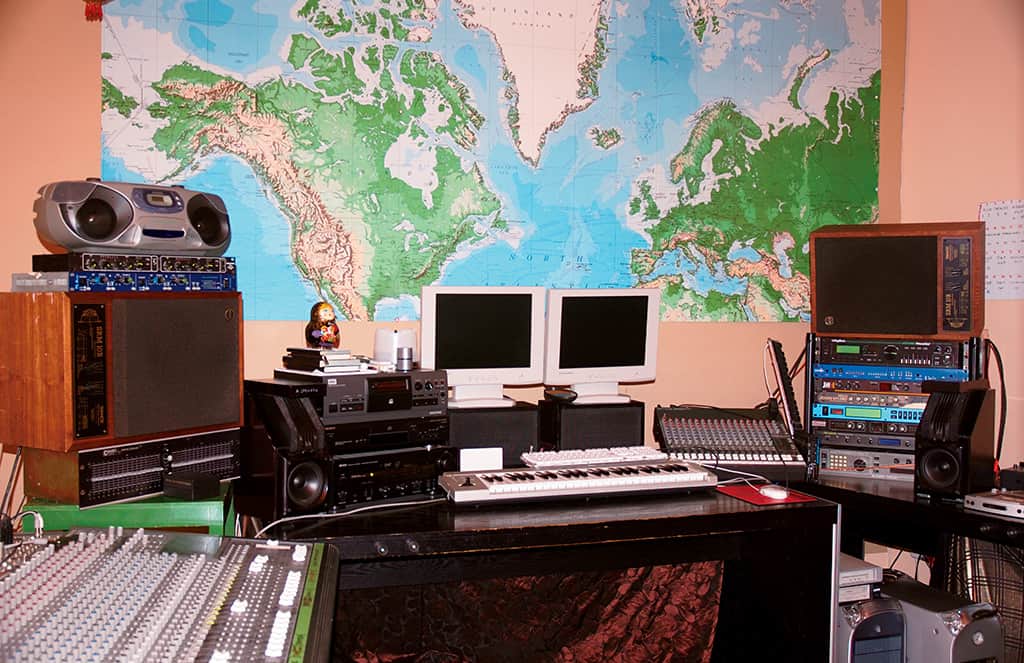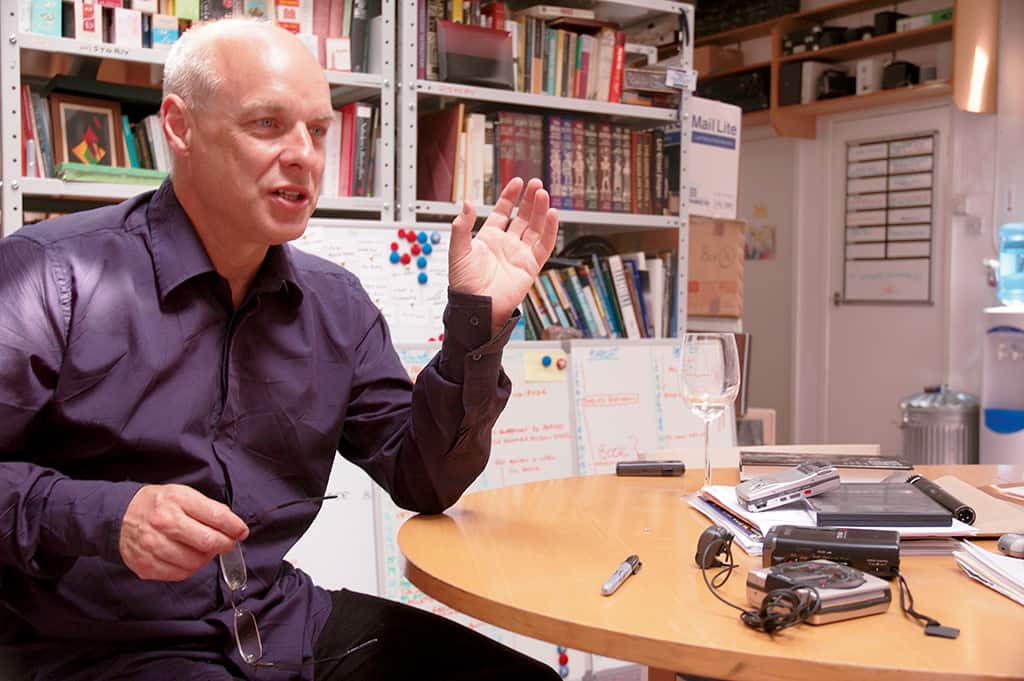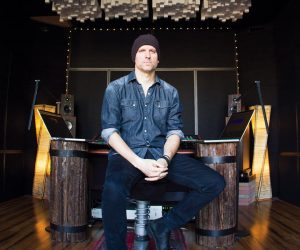
Brian Eno
Brian Eno is one of the most influential artists and producers in the world today. Whenever he opens his mouth, it’s worth listening. Paul Tingen was there to do just that.
Dubbed the ‘professor’ of audio, Brian Eno is one of the most respected musical artists of our time. He’s produced several of the world biggest acts including David Bowie, U2 and Talking Heads. He’s played on countless albums for others as well as recorded a swag of his own ground-breaking records. His music is everywhere and his musical philosophy resonates worldwide. Paul Tingen caught up with the mystery man himself to discuss music, the universe and everything.
Right in the middle of Brian Eno’s workspace in west London is an object that perfectly illustrates the man’s worldview. The large, illuminated globe suspended from the ceiling is unremarkable in its own right. But it comes with a twist: it’s upside down. The symbolism is apt, for throughout his 35-year career, Eno has regularly turned musical instruments, technology, styles, concepts and approaches upside down, offering different perspectives on almost everything he engages with.
“Honour thy error as a hidden intention,” proclaimed the first of a set of cards dubbed Oblique Strategies which Eno devised (with artist Peter Schmidt) in the 1970s, to be used in oracle-like fashion whenever one was feeling creatively stuck. “Familiarity breeds content,” punned Eno in 1999, in an article very critical of computers, opining that when dealing with technology users “prefer deep rapport over endless options.” And, while talking about production – the activity for which he is most famous, having produced legendary albums by David Bowie, Talking Heads, and U2 amongst others – Eno offered: “I figure that the listener requires about half of what you think you require when you’re the creator.”
Agree or disagree, these statements are like a sleight of mind, forcing us to re-evaluate long-held ideas and working principles, which is, of course, exactly what Eno is after. Unlike many musicians operating in the rock field, he rather enjoys conceptualising about the creative process, and he’s not opposed to dragging in systems, emergence, chaos, and evolution theories, or any other intellectual or artistic pursuits that take his fancy.
For instance, he connected Darwinism, composition, architecture, and gardening in one breath, when he noted: “It’s intuitive to think that anything complex has to be made by something more complex, but evolution theory says that complexity arises out of simplicity. That’s a bottom-up picture. I like that idea as a compositional idea, that you can set in place certain conditions and let them grow. It makes composing more like gardening than architecture.”
GENERATING ILLUSIONS
Ever since hearing minimalist composer Steve Reich’s cut-and-paste tape piece, It’s Gonna Rain (1966), Eno has been fascinated with music that generates itself in semi-random fashion – resulting in “complexity arising out of simplicity.” And so Eno has made several pieces consisting of disparate elements spread out over several CDs played by a batch of ghetto blasters in ‘shuffle’ mode, leading to endless never-before-heard variations of the pieces in question.
“It’s Gonna Rain was one of the most important pieces of music in my life,” Eno commented, “and the whole idea of ‘generative music’ really came out of that. With a generative piece you set a machine going and it makes itself, and you as the composer are also the listener. The act of listening is the act of composing – a very different concept from the old romantic idea that the composer pours out these wonderful things to you, the passive listener, with art as a kind of tube that the artist shouts down to the more or less thick listener at the end.”

INTERESTING DECISIONS
One particularly significant “mistake” that turned into a “hidden intention” occurred when Eno spent several months of 1975 bedridden after a car crash. Physically unable to play the role of the “old romantic” composer, and being forced to listen to environmental noises with increased intensity, he hit on the idea of music as an atmosphere, an environment. It fit the concept of generative music like a glove, and this became the germination point of his most influential concept: ambient music.
Starting with Discreet Music (1975), Eno released several now classic ambient albums, like Music for Films (1978), Ambient 1: Music For Airports (1978), Ambient 2: The Plateaux of Mirror (1980, with Harold Budd), Possible Musics (1980, with Jon Hassell), and Ambient 4: On Land (1982). All were wholly or partly composed according to generative principles, often making innovative use of the technology of the day, such as synthesizers, tape machines, and delay lines. (Eno also famously devised the Revox tape delay process that was applied extensively by guitarist Robert Fripp, who unselfishly called it Frippertronics!)
These ambient albums complement Eno’s more traditionally rock, song-based output, first as a member of Roxy Music, then followed by No Pussyfooting (1973, with Robert Fripp), Here Come The Warm Jets (1973), Taking Tiger Mountain (By Strategy) (1974), Another Green World (1975), Before And After Science (1977), and Wrong Way Up (1990, with John Cale). Many of these albums were made with extensive help from other musicians, exemplifying another Eno axiom: “people in groups tend to make much more interesting decisions.”
Like Eno’s fascination with generative music, the latter statement points towards a principle that underlies many of his musical and intellectual activities, namely his aversion to what he calls “the obsession with personality.” Perhaps slightly contradictory from a man who was co-responsible for propelling Bono & Co to world superstar-status, Eno remarked, “This obsession has really held popular music back, in my opinion. Of course, I realise that it’s the nature of what some people do. But I’m absolutely uninterested in the idea of using music as a vehicle for presenting the performer’s personality.”
A huge amount of attention goes into re-cooking the bit of the track that doesn’t need attention. So you need to be very aware of the potential of technology to pull you into ‘screwdriver’ mode

There’s still quite a lot of hate going on for me in working with computers, but I think programs have improved a great deal
UNNATURAL PERFECTION
Given all this, it’s perhaps unexpected that last June saw the release of another Brian Eno solo album, Another Day On Earth, which is his first collection of songs, by his own estimate, for “twenty five years or so.” (It is also the follow-up to the instrumental January 07003: Bell Studies For The Long Now (2003)). So why this return to vocals and songs after so many years?
“Funnily enough,” Eno mused, “when I was doing interviews 25 years ago the first question people asked me was why I had stopped doing vocal albums. Now people ask me why I’ve stopped doing non-vocal albums! The simple answer is that five or six years ago I noticed that I was starting to sing again and enjoying it. Also, since I stopped doing vocal albums and worked on the landscape side of music, certain technological developments have happened that give you the possibility to shape your voice, and that re-awakened my interest.”
“One of the reasons I stopped making vocal records,” Eno continued, “was because I was fed up with the identification that’s always made between the voice on the record and the composer, as if this person singing was some sort of extension of my personality. But I don’t care about my personality being the content of the thing. I always liked the idea of seeing what I was doing the way a playwright might think of a play or a novelist might think of a book. There are characters in there, but they’re not the novelist, they’re just characters in the book. And with the new voice shaping technologies that are around now, you can suddenly make a voice that’s clearly not your own.”
And so Another Day On Earth features many vocal treatments, most notably on the track And Then So Clear, on which Eno’s voice is pitch-shifted upwards an octave, and the vocoder-like effects on Bottomliners. “Quite a lot of the vocal effects were done in Digitech ProVocalist,” revealed Eno, “which I don’t think was ever very popular. It’s a stand-alone box, not a plug-in, and it has lots of interesting functions. It’s an intelligent harmoniser that you can run off a keyboard, so it will harmonise with the notes of the chords that you’re playing. You can have a group of voices following the chords.”
“It also has a gender-changing function, with which you can alter the formant structure of your voice. That’s what I did on And Then So Clear. I also pitched the voice up an octave, and played the melody line on the keyboard as well. The latter gave a very funny effect, because it makes the change between notes slightly artificial in an interesting way. I also applied ProVocalist for the vocoder effect. Plus I used various forms of [Antares] AutoTune a lot. This is very interesting as an effect in that it gives this unnatural perfection to your voice.”
BLUFF & TRUST
Another Day On Earth is striking for its unhurried pace, as if Eno feels that he, and the listener, have all the time in the world. This is a rarity in the ‘three-second attention span’ paradigm that has come to dominate the entertainment industry. “I’ve come to realise that I can trust listeners,” commented Eno. “They don’t need to be constantly woken up. They’re quite happy to drift for a while and come back in when the music comes back in. In general, the listener wants much less than the creator. When you’re creating something, it’s very easy to get into a nervous state and think, ‘Oh god, here’s a whole bar where nothing happens,’ and try to get more stuff in. But as a listener you’re quite happy with these open spaces. I noticed that years ago when I was experimenting with Revoxs, and often found that I preferred the pieces played back at half speed. This was not just because of the softer, more somber tonality, but simply because less happened.”
It’s an observation that Eno didn’t only apply with great success in his ambient works, but also as a producer of best-selling rock ‘n’ roll albums. Recall, for instance, the many empty spaces on U2’s The Joshua Tree. With its general slowness, rich sounds, and lush production Another Day On Earth feels as if it’s the culmination of Eno’s 30 years experience as a producer, while also being an attempt at bridging the gap between his ambient and his song-based work. In this respect the album appears like the follow-up to 1975’s Another Green World, which also featured songs as well as extensive instrumental sections. Eno endorses this speculation.
“The track ‘How Many Worlds’ [on Another Day On Earth] is a very short song with a very long instrumental section. There’s just enough voice in there to make you hear it as a song, making it a bluff, a deceit, and there are a number of bluffs like that on the record. I learned this when I made Another Green World, which had 14 pieces on it, five of them vocal pieces. I noticed that everyone thought about it as a song record, and I was pleased about that, because people bring more quality of attention to a song record than an instrumental record.”
“You can research this. If you have a painting that’s just a landscape, you see the eye moving in a very complex pattern as it scans it. If you put a figure in there, even if it’s minute, then the eye will keep referring back to that. The same thing happens when we hear a voice. So for me it was like, I’ve been doing landscapes for a long time, and now I’ve re-introduced some figures, i.e., the voices. Where are they going to fit? How big will they be? Is it going to be like the Mona Lisa, with a big figure in front of the backdrop, or more like a Constable painting, where it’s just a tiny figure in a large landscape? And how can I destabilise that in some way, how can I put a voice in there and not make it the centre of attention?”

SCREWDRIVER MODE
ProVocalist and AutoTune were two tools that Eno used to experiment with the role of the voice in his music. He also explained that in the track Long Way Down he manually synchronised his vocals with an out-of-time keyboard melody, while in Just Another Day, he repeatedly cut up the main phrase, so that “the listener had little windows on it”. These are effects that can only be done in a computer, and it emerged that Eno recorded most of Another Day On Earth on a Mac, using Logic software. So what has happened to his past objections to computers?
“Well, two pieces, Bottomliner and Under, were started before my computer days, about six years ago, on a [Tascam] DA88,” Eno began his long explanation. “For a while I was in this very awkward in-between land, working partly on DA88 and partly on computer, and this was an awfully clumsy period. I really despise digital tape recording, it’s so fragile. So then over the years I went through various versions of Logic, from 4 to 7.1. There’s still quite a lot of hate going on for me in working with computers, but I think programs have improved a great deal. The objections I used to make have been taken on board more by programmers. Programs are less menu-intensive than they used to be, and Logic is a very evolved program. I also think that plug-in instruments today are very much better than the early ones.”
“The problem remains the interface with the computer keyboard. There are certain decisions that you make on a keyboard that you wouldn’t make on a guitar, and vice versa. You have to stay aware when you start working with a computer that you’re on a very tilted playing field. You’re more likely to do some things than others. It can be very interesting when you try to do something that isn’t within the normal inclination of the computer.”
“For instance, on the track This I began with a bass part, and then tried to fit some drums to that. I have many wonderful drum programs, the best of all being [Steinberg’s] Groove Agent. It has loads of different drums in loads of different styles, but nothing that fit this bass line. In the end I decided that I needed to play the drums, but unfortunately I tend to play slightly ahead of the beat. Yet whenever I quantise my drum performances they still don’t sound right, because that’s not how you feel the beat.”
“It’s very easy to do all these things that computers want you to do, like quantise, or use equal temperament if you’re working with a keyboard, or use endless tracks and editing options, and in that way have the computer determine what kind of music you’re making. This has been fatal for a lot people, because the number of options at every stage proliferates exponentially. What I often see in studios is that when one problem can’t be solved quickly – for instance the lyric writing, which is always a problem – people start working on non-problems, like ‘let’s try 38 different guitar parts on a song’ and ‘let’s play around with the sounds in 150 ways each’. A huge amount of attention goes into re-cooking the bit of the track that doesn’t need attention. So you need to be very aware of the potential of technology to pull you into ‘screwdriver’ mode.”
Eno noted that he welcomes how computers can now be used for generative purposes (he uses Koan generative music software a lot, on the new album for a textural background pad in the track Going Unconscious). And he singles out Native Instruments and Korg as “companies that have both, in their separate ways, made contributions to solving the computer problems I’ve been talking about. I’m a big fan of Native Instrument’s FM7 program, which is sort of based on the Yamaha DX7. It’s the DX7 that I always wanted to have, because you can suddenly connect things in different ways. With the FM7 you can also tune the keyboard in any way you want, so you can make music in just intonation, or Arabic intonation, or whatever.”
“Korg has its Kaoss pads, which are a way of taking sounds into the domain of muscular control. If you have a few Kaoss pads in line, like I do, you can really start playing with the sound itself – with the physical character of it. The pads are very intuitive; anyone can learn to use them in a second. It’s immediately obvious what you do, and it immediately takes you into a completely different place, because when you work with computers you normally don’t use your muscles in that way. You’re focused on your head, and the three million years of evolution that resulted in incredible muscular skill doesn’t get a look in.”
There appear to be some contradictions here, since Eno was once well known for being a master in programming the DX7, arguably the most cerebral and counter-intuitive synthesizer of all time. No wonder he likes the ease-of-use of the FM7, even as he still occasionally used the DX7 on Another Day on Earth, mostly for bass sounds, because of the “sharp attack.” Moreover, doesn’t intuitive, muscular skill bring in more personality, something he’s not too keen on? Eno shook his head. “I would say that, funnily enough, the muscular part is more likely to bring out our collective, shared part, while the brain part is more likely to be the individual, separate part. I feel that when I’m in the muscle world, I’m getting out of this little thing I call Brian Eno, and I feel more connected to a bigger community.”


SACRIFICES
Final mixdown of Another Day On Earth took place inside of his computer. Says Eno, renowned master of treatments: “When I was playing parts live into the computer I would do processing through external boxes. I’d also sometimes feed stuff out of my computer through the Kaoss pads. There’s a lot of plug-in processing going on. I’d usually print the processed track inside of the computer, and then push it back in time, because when there’s a lot of processing you get latency problems. I like working like that, because I can do different things with the already processed track.”
Given Eno’s former strongly worded critical comments, his current almost total surrender to computer recording is a tad surprising. So what about other objections often made, such as that albums recorded entirely inside of computers, and even just in digital, often sound flat and lifeless?
“It’s indeed interesting that after working in computers for a while,” Eno agreed, “when you then listen to something that wasn’t made in a computer, it sometimes has a shocking, sparkling, live-ness to it. But in my opinion you simply have to accept that something happens when working with computers, and you work within that constraint. If you’re a print artist, you know that lithographs will give you a different effect than silk screens. So I’m aware that in working with computers, you exclude certain sonic possibilities – as you do when working with analogue tape. The types of sacrifices you make are different. In working with digital you sacrifice certain possibilities of sonic range and depth, while in working with analogue you sacrifice all the operational freedom that comes with computers.”
Eno also reckoned that today’s higher sampling rates and bit resolutions mean the sonic problems associated with digital “are being solved”. Yet he immediately put his argument about the sonic distinctions between analogue and digital in perspective. “I’m not sure it’s so much to do with the internal characteristics of the media, as with the different ways that you work when you’re using them. When you work with analogue, you tend to go for a performance, because it’s too complicated to cut up tape, and so on. So you tend to do takes until you get a good performance. But with digital you say, ‘that’s a good bar, we’ll copy that a few times’.”
“Also, when you work with digital, you tend to work with people who aren’t sound engineers; they’re computer operators. Or at least they’re not people who have spent their lives listening to drum sounds and thinking, ‘I wonder how I can make that sound better, perhaps with this compressor instead of that one, or perhaps if I move that mic a little bit away from the drums’. I think that’s a different world, and the most important distinction between analogue and digital is not to do with the technologies themselves, but with all the aspects surrounding these technologies.
“I engineered Another Day On Earth myself, because otherwise I would have had to spend six years in a commercial studio and pay staff, and that would have become too expensive. But on the song Under the drums were recorded by someone else, a long time ago. When you listen to the album, the drums on Under are definitely the best-sounding drums on there, and that’s not only because it’s one of the world’s best drummers playing [Willie Green] but also because he was recorded by an engineer who was very good at recording drums. But people that work with computers normally sit on their own, and are simultaneously being musician, engineer, composer – all these different jobs. It may be humbling to say, but perhaps we’re not all equally good at all these jobs, and there’s a reason for calling in the experts.”
DRAWING BOARD
In making Another Day On Earth Brian Eno didn’t distinguish between acting as a producer or as an artist. In keeping with his resistance to the idea of “personality”, he’s reluctant to define himself or the roles he plays too rigidly. It’s the reason why he’s decided to sell his studio, and fully enter the computer-only world. “I’m fed up with having a studio. I want to get rid of everything. It gives me the wrong idea about what my job is. I don’t want to get up in the morning anymore, thinking, ‘Oh, I’d better do some music today’, because all this equipment is sitting around looking at me and expecting me to use it. I’d like to get up and think, ‘what shall I do today?’ and this could be music, but also something else.”
So in Eno’s postmodern, post-personality, post-romantic-composer, post-absolute-roles and post-absolute-values universe, where does meaning and intention come in? “I have nothing to say,” responded Eno with some vehemence. “I don’t want to say anything. I have a lot to say when you’re asking me questions [laughed], but I don’t want to use music as a way of saying things. I want to use music as a way of making things happen to me. I want to make things that create emotional or mental conditions for me, and one of the most important conditions is surrender. My yardstick for what constitutes good music is that it changes me. Do I think, ‘wow, that’s a new conception of how things could be’ or ‘that’s a new set of feelings that I have never experienced before’?
“Some of the [1970s] Miles Davis stuff did that to me. Listening to it gave me a sense of getting a glimpse of another world, almost like a sci-fi story. I’ve always had touchstones of music like that, to which I listen over and over again. It’s Gonna Rain was one of those… the third Velvet Underground album another. And most recently there’s an extraordinary band called The Books. I’m glad I only heard them after I released my last album, otherwise I would have gone back to the drawing board.”
“Nearly everything I do starts as an experiment anyway, and the vast majority of things never make it on record. They’re failures because they’re not interesting pieces of music, but they teach me something. Someone once asked Edison why he patented several hundred different types of light bulbs before he hit on one that worked. He said, ‘I’ve discovered a thousand ways of how a lightbulb doesn’t work.’ If you take that experimental attitude, nothing that you do is a failure.”
















RESPONSES